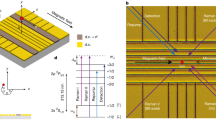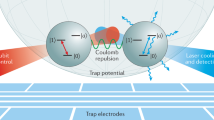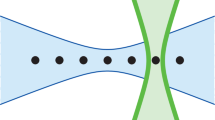Abstract
In this study, we evaluate the effect on ion-trap quantum computers (QCs) from the quantum nature of the driving field, and propose a theoretical limit for ion-trap QCs that may impact the design of quantum algorithms and realization of practical QCs. We obtain, for the first time, the permitted depth of logical operation for fault-tolerant ion-trap QCs. Physically, we provide an exact (full-quantum) description of the QC system, and present for the first time its time evolution after gate operations; mathematically, we solve problems such as certain summations of trigonometric series with any given precision. Comparing the actual state after CNOT gates driven by a quantized field with the expected state, we obtain the failure probability and estimate that the number of CNOT gates on the same pair of physical qubits is not more than 102 in one error-correction period, which is a physical limit that cannot be easily overcome. The conclusion can help determine the number of CNOT operations between coding and decoding in one error-correction period and can be used as a reference for quantum algorithm design.
Similar content being viewed by others
References
Shor P W. Algorithms for quantum computation: discrete logarithms and factoring. In: Proceedings of 35th Annual Symposium on Foundations of Computer Science, 1994. 124–134
Grover L K. A fast quantum mechanical algorithm for database search. In: Proceedings of the 28th Annual ACM Symposium on Theory of Computing, 1996. 212–219
Deutsch D, Jozsa R. Rapid solution of problems by quantum computation. In: Proceedings of the Royal Society of London A: Mathematical, Physical and Engineering Sciences, 1992. 553–558
Bernstein E, Vazirani U. Quantum complexity theory. SIAM J Comput, 1997, 26: 1411–1473
Simon D R. On the power of quantum computation. In: Proceedings of the 35th Annual Symposium on Foundations of Computer Science, 1994. 116–123
Rivest R L, Shamir A, Adleman L. A method for obtaining digital signatures and public-key cryptosystems. Commun ACM, 1978, 21: 120–126
Elgamal T. A public key cryptosystem and a signature scheme based on discrete logarithms. IEEE Trans Inform Theor, 1985, 31: 469–472
Cirac J I, Zoller P. Quantum computations with cold trapped ions. Phys Rev Lett, 1995, 74: 4091–4094
Linke N M, Maslov D, Roetteler M, et al. Experimental comparison of two quantum computing architectures. Proc Natl Acad Sci U S A, 2017, 114: 3305–3310
Monroe C, Raussendorf R, Ruthven A, et al. Large-scale modular quantum-computer architecture with atomic memory and photonic interconnects. Phys Rev A, 2014, 89: 022317
Piltz C, Sriarunothai T, Varón A F, et al. A trapped-ion-based quantum byte with 10(-5) next-neighbour cross-talk. Nat Commun, 2014, 5: 4679
Khromova A, Piltz C, Scharfenberger B, et al. Designer spin pseudomolecule implemented with trapped ions in a magnetic gradient. Phys Rev Lett, 2012, 108: 220502
Bowler R, Gaebler J, Lin Y, et al. Coherent diabatic ion transport and separation in a multizone trap array. Phys Rev Lett, 2012, 109: 080502
Pagano G, Hess P W, Kaplan H B, et al. Cryogenic trapped-ion system for large scale quantum simulation. Quantum Sci Tech, 2018, 41
Harty T P, Allcock D T C, Ballance C J, et al. High-fidelity preparation, gates, memory, and readout of a trapped-ion quantum bit. Phys Rev Lett, 2014, 113: 220501
Ballance C J, Harty T P, Linke N M, et al. High-fidelity quantum logic gates using trapped-ion hyperfine qubits. Phys Rev Lett, 2016, 117: 060504
Gaebler J P, Tan T R, Lin Y, et al. High-fidelity universal gate set for 9Be+ ion qubits. Phys Rev Lett, 2016, 117: 060505
Leung P H, Landsman K A, Figgatt C, et al. Robust 2-qubit gates in a linear ion crystal using a frequency-modulated driving force. Phys Rev Lett, 2018, 120: 020501
Monz T, Nigg D, Martinez E A, et al. Realization of a scalable Shor algorithm. Science, 2016, 351: 1068–1070
Gea-Banacloche J. Some implications of the quantum nature of laser fields for quantum computations. Phys Rev A, 2002, 65: 022308
van Enk S J, Kimble H J. On the classical character of control fields in quantum information processing. Quantum Inf Comput, 2002, 21: 1–13
Yang L, Yang B Y, Chen Y F. Full quantum treatment of rabi oscillation driven by a pulse train and its application in ion-trap quantum computation. IEEE J Quantum Electron, 2013, 49: 641–651
Yang L, Chen Y F. A decoherent limit of fault-tolerant quantum computation driven by coherent fields. In: Proceedings of SPIE, 2007. 682708
Nielsen M A, Chuang I L. Quantum Computation and Quantum Information. Cambridge: Cambridge University Press, 2010
Knill E. Quantum computing with realistically noisy devices. Nature, 2005, 434: 39–44
Milburn G J, Schneider S, James D F. Ion trap quantum computing with warm ions. Fortschr Phys, 2000, 48: 801–810
Sørensen A, Mølmer K. Quantum computation with ions in thermal motion. Phys Rev Lett, 1999, 82: 1971–1974
Häffner H, Roos C F, Blatt R. Quantum computing with trapped ions. Phys Report, 2008, 4694: 155–203
Gruska J. Quantum Computing. New York: McGraw-Hill, 1999
Knill E, Laflamme R. Concatenated Quantum Codes. Technical Report, quant-ph/9608012. 1996
Liang M, Yang L. A note on threshold theorem of fault-tolerant quantum computation. 2010. ArXiv: 1006.4941
Watrous J. Theory of Quantum Information. Waterloo: University of Waterloo Fall, 2011
Luo X L, Zhu X W, Wu Y, et al. All-quantized Jaynes-Cummings interaction for a trapped ultracold ion. Phys Lett A, 1998, 237: 354–358
Mandel L, Wolf E. Optical Coherence and Quantum Optics. Cambridge: Cambridge University Press, 1995
Born M, Wolf E. Principles of Optics: Electromagnetic Theory of Propagation, Interference and Diffraction of Light. Cambridge: Cambridge University Press, 1999
Cohen-Tannoudji C, Dupont-Roc J, Grynberg G. Atom-Photon Interactions. New York: Wiley, 1992
Silberfarb A, Deutsch I H. Continuous measurement with traveling-wave probes. Phys Rev A, 2003, 68: 013817
Sargent M, Scully M O, Lamb W E. Laser Physics. New Jersey: Addison-Wesley, 1974
Wineland D J, Monroe C, Itano W M, et al. Experimental issues in coherent quantum-state manipulation of trapped atomic ions. J Res Natl Inst Stand Technol, 1998, 103: 259
Steane A. The ion trap quantum information processor. Appl Phys B, 1997, 64: 623
Aliferis P, Gottesman D, Preskill J. Accuracy threshold for postselected quantum computation. Qantum Inf Comput, 2008, 83: 181–244
Weidt S, Randall J, Webster S C, et al. Trapped-ion quantum logic with global radiation fields. Phys Rev Lett, 2016, 117: 220501
Lekitsch B, Weidt S, Fowler A G, et al. Blueprint for a microwave trapped ion quantum computer. Sci Adv, 2017, 3: e1601540
Acknowledgements
This work was supported by National Natural Science Foundation of China (Grant No. 61672517), National Cryptography Development Fund (Grant No. MMJJ20170108), National Key R&D Program of China (Grant No. 2016QY03D0503), and Beijing Municipal Science & Technology Commission (Grant No. Z191100007119006).
Author information
Authors and Affiliations
Corresponding author
Rights and permissions
About this article
Cite this article
Yang, B., Yang, L. Effect on ion-trap quantum computers from the quantum nature of the driving field. Sci. China Inf. Sci. 63, 202501 (2020). https://doi.org/10.1007/s11432-019-2689-4
Received:
Revised:
Accepted:
Published:
DOI: https://doi.org/10.1007/s11432-019-2689-4




